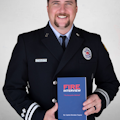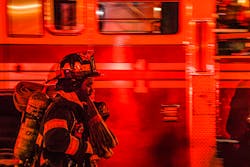We have a saying in the fire service: “Tradition unimpeded by progress.” This certainly rings true regarding our hiring processes. In recent years, we have seen a 50 percent drop in the applicant pool nationwide. In addition, the fire service is struggling to promote diversity, equity and inclusion in the hiring process.
How did this happen and how do we fix it? Was it a result of COVID? Is it because of the cost of college in conjunction with rising minimum qualifications to apply or, as my grandpa might say, because “This generation just doesn’t want to work hard.”
Many factors affect recruitment efforts, but the one that we can control is the hiring process.
Expand the search via social media
Many of you likely are familiar with the saying “The definition of insanity is doing the same thing over and over and expecting different results.” Nevertheless, we continue to facilitate firefighter hiring processes the same way that we did 30 years ago.
There are three steps to a successful hiring process:
- Cast a big net
- Make it easy to apply
- Help the candidates be successful
The more people who know you are hiring, the more qualified applicants you’ll get and the more diversity you’ll have in your testing pool.
After you planned your hiring process and set your timelines, it’s time to advertise that applications are open, but advertise where?
One of the most surprising things that we found is how many departments still hang up flyers, advertise in the newspaper, and count on city websites, Facebook or word of mouth alone.
Keep in mind the age group that you are trying to attract. Most of your candidates get their information from Instagram, and many of them are moving toward TikTok. If you aren’t advertising your recruit firefighter positions on Instagram, most of your target audience never will know that you even had a job opening.
It’s imperative that you put social media communication at the forefront of your efforts—and not only for recruitment. It’s the number one way in which you can communicate with your community about emergencies, events and anything else.
Eliminate on-site written exam
One of the positive things that came out of COVID is that it really forced us to look at how we conduct the written portion of the test and to compare that with colleges and private sector companies.
The most significant thing that we can do to increase the candidate pool and to promote diversity is to eliminate convention center Scantron testing and testing centers. It isn’t 1995 anymore, and there’s a better way.
Use an online exam that candidates can take from anywhere in the world 24/7. Whether someone is testing from out of state, is deployed overseas in the military or has a 9-to-5 job, showing up to a physical location at a specific date and time is an unnecessary hardship.
Video interviews
The late Chief Alan Brunacini once said that there are two things that firefighters hate: change and the way things are.
As a former executive board member for the IAFF, I oversaw recruitment and promotional processes. When I first heard about video interviews, I was completely against them. I wanted applicants to sweat it out in front of me, just as I had to do.
First things first: We don’t recommend that you eliminate in-person interviews from your department’s hiring procedures. Think of the video interview more as a video screening process.
I’m sure that many of you can relate to the 70 percent rule: Out of 10 interviews, one of them is terrific, and two of them are just OK. The other seven aren’t a good fit. Whether those seven had 30 minutes to interview but finished in three minutes or were a no-show, they wasted time and money for both parties. By utilizing video interview screenings, you can get higher quality candidates as well as reduce no shows for the in-person interviews. In addition, you can review six or seven times the number of candidates. The Clark County, NV, Fire Department reviewed 900 video interviews in one week and then brought in the highest quality candidates for in-person interviews.
By looking at so many more people, you can see a much more diverse candidate pool. As Brunacini also said, “They can’t all be the next fire chief; someone still has to kick down the door,” and we know that there are plenty of great candidates who score in the 70s and 80s on the written exam. We just never were able to interview them in the past, because we weren’t utilizing technology to our advantage.
Then there’s this: “I have a friend who’s a great candidate but can’t seem to get past the written.”
The truth is, we shouldn’t label candidates as just a test score. Some candidates are good at taking tests, some are good at interviewing. We want to get a 360-degree view of the candidate. By not only evaluating their scores but also viewing their video interview, all candidates are able to put their best foot forward.
Video interviews are viewed and scored by your own personnel. This keeps your organization in control of selecting the firefighters who you want while seeing way more candidates, promoting diversity, equity and inclusion, and saving money and time.
Single-source testing
Single-source testing is using one firm for your recruit testing process.
Departments are losing a large percentage of their applicants by using too many firms: one firm for applications, another for testing, another for videos, another for behavior testing, and so on and so forth. By using one firm, candidates can complete all of the steps in the initial recruitment process on one website instead of waiting for a new email every week that redirects them to the next step in a long, drawn out testing process with multiple companies.
Single-source testing drastically reduces the number of candidates who you lose from initial applications to in-person interviews.
Must know a firefighter to be a firefighter
The panel-style interviews and overall fire department hiring process differ so much from the private sector that most candidates end up testing for years before they finally get the right advice and can navigate the competitive processes successfully. The interview seems to be the largest hurdle for most candidates.
In the interest of helping candidates succeed, I wrote “Fire Interview: The Storyteller Method.” Some departments offer a seminar for applicants to learn what to expect and how to prepare for the hiring process. Preparing the candidates in conjunction with an efficient and effective hiring process is the key to hiring the right people.
Success comes from progress
The fire service has a choice when facing issues, of whatever sort: Be proactive or be reactive.
Firefighter recruitment is a struggle for organizations across the country. I encourage you to evaluate your hiring process and to embrace progress, because it’s the key to future success. That is why we created Public Safety Answers (PSA), which is a firefighter recruit testing company made by firefighters for firefighters, to address all of the issues that are noted above to bring our hiring processes into the 21st century.
About the Author

Brendon Trayner
Brendon Trayner is an 18-year veteran of public safety. He has served the past 11 years at Gilbert, AZ, Fire and Rescue as a captain. Trayner also served as an executive board member for the IAFF, during which time he oversaw recruitment and promotional processes. He is the author of “Fire Interview: The Storyteller Method” and the host of The Storyteller Podcast. Trayner is a founding member of Public Safety Answers, which is a firefighter recruit testing company that's committed to bringing firefighter testing into the 21st century. To connect, you can reach Trayner at [email protected].
